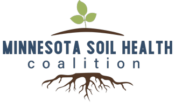So it’s the time of year to spend more time inside, review how 2019 went, go over financials, and plan for 2020. What are you looking at for the coming year? This is the perfect time to plan, take the time to evaluate what your ground needs – do you need to increase infiltration, increase organic matter, improve tilth, improve the cycling of nutrients, control herbicide resistant weeds, add more carbon to have lasting residue, fix nitrogen? Really pin point the needs of your ground and then starting working at a plan to meet those objectives. There are countless sources of information available, finding the right recommendations for your land, management, climate, and objectives can seem daunting and frustrating.
Talking with others in your area to learn about what has been successful and what hasn’t is very useful, there are countless ways to cut a pizza, not one single way is correct, and it all depends on how you want to eat it. Soils that are sandier will have different objectives than heavy clay soils, higher rainfall and colder temperatures dictate different timing, it’s an evolving puzzle that isn’t set in stone but is possible to put together.
Objectives change over time too, when first starting out, cycling organic matter quickly to reduce nitrogen tie up is essential but as your soils regenerate, it is difficult to keep enough residue in and on the soil to meet the demand. Farmers have so many items to consider and manage, planning and learning are your best management strategies to conquer issues and meet objectives.
How do we determine your plan? First take stock and determine where you are, then determine your objectives.
There are easy ways to get started, planting cereal (winter) rye before soybeans and planting green, upping the game and interseeding a 4 way or more mix in your corn between V4-V6 to feed the biology and increase nutrient cycling, or establishing clovers as a living cover in your corn ground for soil protection and fixing nitrogen.
Check out this easy mix guide that meets NRCS standards and specs and provides mixes based on objectives and includes herbicide interactions https://mnsoilhealth.org/wp-content/uploads/2019/09/Cover-Crop-Inventory_All.pdf
Talking with our farmer mentors can provide a sounding board and a friendly voice. They are Minnesota farmers that have implemented soil health practices and are willing to discus their experience and provide you with input and information to help with questions, feedback, trouble-shooting, and more. Find them at https://mnsoilhealth.org/mentor/
This is the perfect time to sign up for EQIP for cover crops, nutrient management, reduced tillage, irrigation water management, pest management, prescribed grazing, and other practices. Stop by your local field office to find out what’s available and to submit an application. Filling out an application doesn’t lock you in, it puts your foot in the door, you’ve got nothing to lose! Find your local NRCS field offices: https://www.nrcs.usda.gov/wps/portal/nrcs/mn/contact/local/
You can also do frost seeding of clovers and/or cereal to get a head start for the spring!

